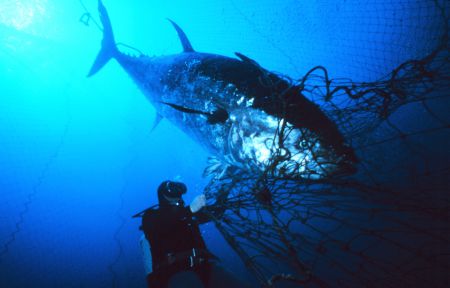I encountered my first Bluefin tuna on a crisp fall morning back in 2012. I was working as a reporter on Prince Edward Island, having only just moved there from Ontario, a place without fish of such tremendous size. I remember regretting the tuna was dead during our first meeting, hanging by its tail from a crane over the humble harbour at Seacow Pond.
These fish, which can grow a frightening three metres in length and weigh 680kg, visit Canadian waters between July and November, taking advantage of our bountiful waters on the Scotian Shelf, in the Gulf of St Lawrence and on the Grand Banks of Newfoundland.
The western Atlantic Bluefin tuna, like so many aquatic species before them, were destroyed by overfishing. Their dramatic drop in population was first recognized in the 1970s, but likely began long beforehand, leaving us to guess how large this population used to be.
From 1970 to 1992, Canada, Japan and the United States forced this population into a steady decline until it stabilized through the 1990s. In that decade, the number of sexually mature tuna staggered between 25-30 per cent of their 1970 levels, a neck and neck race against extinction which eventually turned in their favour.
In 1998, the International Commission for the Conservation of Atlantic Tuna (ICCAT) adopted a 20 year plan to rebuild the western stock. Harsh quotas were put into place and the tuna began a slow recovery. In recent years, quota dropped from 1,900 tonnes in 2009 to 1,800 tonnes in 2010 and held at 1,750 tonnes from 2011 until 2014. Canada enjoyed 23 per cent of this quota.
In 2003, the tuna population on our coast was 32 per cent of its 1970 levels. According to an ICCAT assessment published last year, by 2013 the Bluefin achieved an estimated 55 per cent. It appeared the tuna were coming back, but these numbers turned out to be a mixed blessing for the Bluefin.
Governments and fisheries alike were prompted by this news to ask for increased quota. Canada and the Maritime fisheries were among them, pushing for 2,000 tonne for 2015 and 2016. Conservationists met them head on, saying it was much too early to increase quotas, now that this population was showing its first signs of recovery in 40 years. If it’s not broken, don’t fix it.
At face value, the numbers mentioned above do appear optimistic, but as the assessment was quick to mention, they might be wrong.
“The [research arm of the ICCAT] cautions that the conclusions of this assessment do not capture the full degree of uncertainty in the assessments and projections.”
It says tuna from the other side of the Atlantic, from the much larger eastern population, often visit our shores to feed and artificially inflate our numbers. We don’t know by how much. Researchers are also uncertain how quickly Bluefins reproduce and mature. So, that 55 per cent recovery might be incorrect, as might our projections into the future, including the projection used to justify an increased quota. There were a host of other uncertainties mentioned in the assessment, but quota was finally increased.
Does a 55 per cent recovery justify an increase in quota? Can the tuna handle any additional abuse? Quotas were raised four times since the 1970s whenever tuna showed signs of recovery, which is part of the reason this fish has never bounced back. If we insist on catching the absolute maximum this population can afford, it will never achieve its historical abundance. At the very least their recovery will be slowed for short term benefit.
The Maritime fisheries are among the most sustainable in the world. Its members have time and again made sacrifices for the health of the oceans, enduring personal expense to avoid taking too much. Having spent time with the men and women who make up this fishery, I can tell you they have no desire to see the Bluefin vanish, not for the sake of their income but because they have a relationship with our coast. The tuna is a profitable fish in a struggling fishery.
It comes back to us, really - the multitudes of us willing to purchase and eat an endangered species. The Atlantic Bluefin tuna was declared endangered in 2011 by the Committee on the Status of Endangered Wildlife in Canada (COSEWIC), but we collectively failed to draw the connection between this struggling fish and the canned seafood we mix with mayonnaise and spread on toast.
I respect and applaud our fishery in Atlantic Canada and will continue to support it with my business, but I haven’t eaten tuna since that clear fall day back in 2012.



